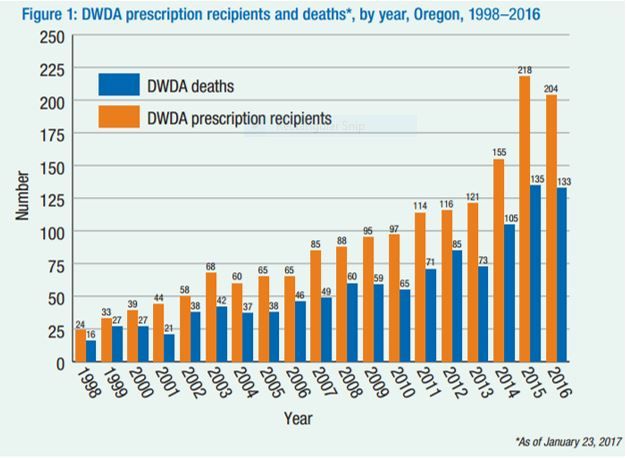Publication
Article
Pharmacy Times
Death With Dignity: A Right or a Crime?
Five states—Oregon, Washington, Vermont, Colorado, and California—and the District of Columbia now have Death With Dignity acts.
By the time of his death in 2011, Dr. Jack Kevorkian was said to have assisted in the suicides of at least 130 patients. In part because of his advocacy, physician-assisted suicide became a heated topic of discussion in the 1990s.1
Five states—Oregon, Washington, Vermont, Colorado, and California—and the District of Columbia now have Death With Dignity acts that allow adults with a prognosis of no more than 6 months to live to choose to end their lives. Montana allows an “end-of-life option” via a ruling of the state’s supreme court in 2009.2 The intent of such laws is to help terminally ill patients avoid undue pain and suffering and allow them more autonomy in decisions concerning their end-of-life care. Participating individuals must be mentally competent, able to voluntarily request and obtain the necessary prescription, and self-administer the medication.3 Most participants are younger than 65, have received a diagnosis of terminal cancer, and are in hospice care.4 All health care providers involved in the process are legally protected from charges of assisted suicide, homicide, and elder abuse.2
Death with dignity is a controversial issue. Thirty-seven states have laws expressly prohibiting physician-assisted suicide,5 and physician opponents say that actively participating in the death of a patient violates the Hippocratic Oath, which instructs doctors to “do no harm.” Health care systems with religious affiliations also oppose death with dignity, claiming that death is a “sacred part of life’s journey” that should neither be hastened nor delayed.2 Furthermore, there is concern that such laws open the door to potential abuse.6 The determination of a patient’s prognosis can be arbitrary, and physicians are not held accountable for the life-ending drugs that they prescribe. This lack of accountability may lead to patients being pressured by physicians or family members into committing suicide or using physician-assisted suicide to avoid exorbitant medical bills.6 In response, because an individual’s decision to die with dignity is viewed as strictly voluntary, health care providers, hospitals, and physician groups may opt out without the risk of penalty.2
Advocates of death with dignity argue that the practice is uncommon; a physician may encounter the situation only once or twice in a career. Further, since the passage of the Oregon law in 1997, fewer than 2000 prescriptions for lethal drugs have been written in Oregon, and just 65% have been used. This is a pattern that is consistent year after year (FIGURE 1).4 Moreover, choosing to die is not an instantaneous decision. For example, Oregon law requires patients to make 2 oral requests to their physician at least 15 days apart, followed by a written request signed in the presence of 2 witnesses. The attending physician must then confirm the patient’s diagnosis and prognosis with a consulting physician. If either provider believes that the patient’s judgment is impaired by a psychiatric or psychological disorder, then a referral for a psychological evaluation must be made. If all requirements are met, then the physician must inform the patient of all reasonable alternatives to death with dignity. If the patient confirms their decision, the medication must be dispensed directly to the patient by the physician or via a written prescription delivered to a pharmacist either by the physician or through the mail. The patient may rescind the request at any time.3 Such conditions ensure that the physician’s and the patient’s judgments are neither hastened nor coerced.
Prescriptions for the high doses of oral barbiturates that are typically used in physician-assisted suicide may end up in the hands of a community pharmacist.4 This raises important considerations for the pharmacist, including patient-counseling issues, legal requirements, moral and ethical concerns, and consequences for refusing to dispense the medication. The American Society of Health-System Pharmacists released a statement in 1999 regarding pharmacists’ participation in death with dignity. The statement indicates that it is the duty of a pharmacist to provide patient-specific care and to respect the autonomy of the patient but that it also is the right of the pharmacist to choose not to participate in “morally, religiously, or ethically troubling therapies.”7
End-of-life care presents a great opportunity for pharmacists to exercise their expertise. Physicians and pharmacists must contemplate the implications of death with dignity laws on their personal beliefs and future practice to provide empathy, understanding, and the best possible care to their patients.

Source: Oregon Health Authority Public Health Division, Center for Health Statistics. February 2017.Erin N. Deja is a fourth-year PharmD student at the University of Kentucky College of Pharmacy.Joseph L. Fink III is a professor of pharmacy law and policy and the Kentucky Pharmacists Association Endowed Professor of Leadership at the University of Kentucky College of Pharmacy, Lexington.
References
- Davey M. Kevorkian speaks after his release from prison. The New York Times website. nytimes.com/2007/06/04/us/04kevorkian.html. Published June 4, 2007. Accessed June 6, 2017.
- LeBlanc J, Struve A, Mendoza L, Levy M. Difficult choices for healthcare providers as California legalizes assisted suicide. Lexology website. lexology.com/library/detail.aspx?g=ad4f41bd-ce90-48da-bce2-345bc3fcfcfa. Published October 10, 2016. Accessed June 6, 2017.
- Oregon Death with Dignity Act. Ore Stat §127.800.
- Oregon Health Authority, Public Health Division, Center for Health Statistics. Oregon Death with Dignity Act. Data summary 2016. Oregon state website. public.health.oregon.gov/ProviderPartnerResources/EvaluationResearch/DeathwithDignityAct/Documents/year19.pdf. Published February 10, 2017. Accessed June 6, 2017.
- Gray K. Bill legalizing assisted suicide gets new life in Lansing. Detroit Free Press website. freep.com/story/news/politics/2016/08/13/bill-legalizing-assisted-suicide-gets-new-life-lansing/88537468. Published August 13, 2016. Accessed June 6, 2017.
- Judge refuses to suspend California’s assisted death law. Modern Healthcare website. modernhealthcare.com/article/20160827/NEWS/160829934. Published August 27, 2016. Accessed June 6, 2017.
- ASHP statement on pharmacist’s decision-making on assisted suicide. Am J Health-System Pharm. 1999;56(16):1661-1664.







